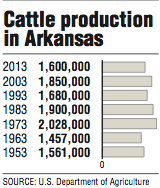The drought that plagued the nation’s crops and livestock for two years is still causing residual effects for ranchers and farmers. The cattle inventory has decreased to a 50-year national low, while the cost of cattle has reached an all-time high.
In 2012, cattle producers saw a loss of more than $120 million, mostly because of rising hay prices, reduction in hay sales, short corn crops and higher-than-average fuel prices. Those factors made it difficult for farmers to continue to produce cattle, and many were faced with a choice: sell part of their herd to be able to feed what they had left or borrow money from banks.
Gary Proctor, a farmer from Lincoln, opted to sell. Last year, he sold almost half his herd, and after this year’s 45-day dry spell, he sold several more.
Once conditions improved, Proctor began looking to restock his herd but reached an impasse. “There’s no cattle to replace it with - no one kept replacements,” he said.
When the demand for beef is high, cows are taken out of the production cycle and sold.
“It takes a long time to replenish once you sell adult cows,” said Johnny Gunsaulis, a county extension agent with the University of Arkansas Division of Agriculture. “The calves have to be two before they can begin to reproduce, and it could take three to four years to produce [beef].”
Travis Justice, executive director for the Arkansas Beef Council, cautioned that cattle production will continue on a steep decline and “may take 15 years to stabilize.”
Nationally, the cattle population dropped to 89.2 million in 2013, a 4.9 percent decrease from 93.8 million in 2010.
“Data indicated a reduction in cattle, and given the intermediate data, we can predict another drop in the cattle count,” Justice said.
The number of cattle in Arkansas experienced a steeper decline to 1.6 million in 2013, a 16.2 percent decrease from 1.9 million in 2010.
Cattle counts vary by month, and population data generally has a six-month lag because the U.S. Department of Agriculture’s National Agricultural Statistics Service only conducts surveys twice a year, in January and July.
Because of the reduction in population, the price for beef has reached record highs,which consumers have already seen at the supermarket.
As of August, the national average for a pound of lean ground beef was $4.89, up from $3.58 in 2010, which is an increase of 36.6 percent, according to the Bureau of Labor Statistics.
“Some people were not able to feed their cattle normally; we saw a decreased harvest weight, which produces less meat,” Justice said. “Anytime there is a reduction in supply of a product, there is pressure to raise the prices.”
The cattle market has historically had ups and downs, but the current cattle count is concurrent with numbers from the 1950s.
The drought and an aging cattle farmer population is blamed for the downward trend.
Diane Balich, a large-animal veterinarian and rancher, said that production is not down for her because she raises registered cattle, unlike the national herd, which is commercial cattle. Registered cattle are typically one breed, and they are not cross-bred. However, registered cattle can be sold to farmers as replacement stock for commercial cattle, which is generally cross-bred for consumption.
“The decline has to do with money - there’s no money in cattle, so many people are getting out of the cattle business, young people aren’t interested, and banks aren’t loaning like they used to,” Balich said.
Tom Troxel, a University of Arkansas animal science professor, said that the interest he has seen from young farmers is limited because of the rising costs of cattle, land and equipment.
“It’s a difficult business to get in to because it’s so expensive,” Troxel said. “Cattle is going for $1,500 to $1,800 a head now, when in previous years it went for $800 to $1,000 or less.”
Balich agreed. “Everyone is losing money, and it’s not getting better. Yes, cattle is selling for twice as much, but it costs 10 times as much to raise them,” she said.
Cary Batholomew, farmer and rancher in Prairie Grove and field representative at the Stillwell Livestock Auction in Oklahoma, said that he hasn’t seen herds sell like last year, mainly because of the availability of hay.
“Corn prices are coming down, and there is lots of hay and lots of grass, so there haven’t been as many sell-offs,” Bartholomew said.
The events that transpired in the last few years has created the perfect storm and contributed to lower production and higher retail prices, Justice said.
“It’s just a numbers game now,” Justice said. “Our goal is to get back to the same production level like before, but we are limited by weather, the biology of the animal and production costs.”
Business, Pages 23 on 10/01/2013

